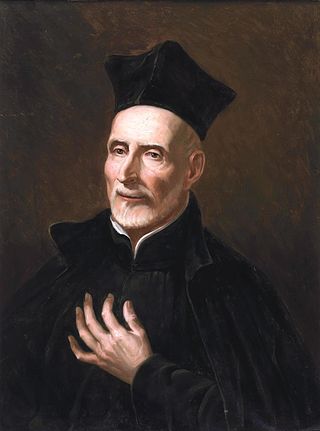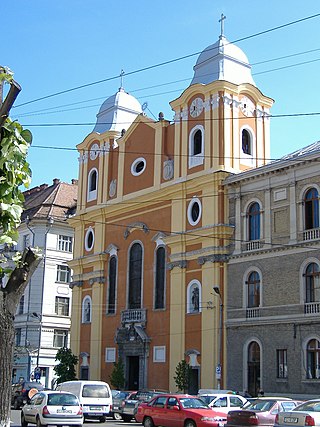
Opole Lubelskie is a town in southeastern Poland. As of 2004, it had 8,879 inhabitants. The town is situated in Lublin Voivodeship, some 10 kilometers east of the Vistula River, and is the capital of Opole Lubelskie County. It was founded in the 14th century, and historically belongs to Lublin Land, which is part of Lesser Poland.

Mosonmagyaróvár is a town in Győr-Moson-Sopron County in northwestern Hungary. It lies close to both the Austrian and Slovakian borders and has a population of 32,752.

Prievidza is a city in the central-western Slovakia. With approximately 46,000 inhabitants it is the second biggest municipality in the Trenčín Region and 11th largest city in Slovakia generally.

Missa in tempore belli is a setting of the mass by Joseph Haydn. It is catalogued Mass No. 10 in C major. Known also as the Paukenmesse due to the dramatic use of timpani, it is one of the most popular of his fourteen mass settings. The autograph manuscript contains the title "Missa in tempore belli" in Haydn's handwriting.

The Piarists, officially named the Order of Poor Clerics Regular of the Mother of God of the Pious Schools, abbreviated SchP, is a religious order of clerics regular of the Catholic Church founded in 1617 by Spanish priest Joseph Calasanz. It is the oldest religious order dedicated to education, and the main occupation of the Piarist fathers is teaching children and youth, the primary goal being to provide free education for poor children. The Piarist practice was to become a model for numerous later Catholic societies devoted to teaching, while some state-supported public school systems in Europe also followed their example. The Piarists have had a considerable success in the education of physically or mentally disabled persons. Notable individuals who have taught at Piarist schools include Pope Pius IX, Goya, Schubert, Gregor Mendel, Tadeusz Kościuszko, and Victor Hugo.

Johann Lukas von Hildebrandt was an Austrian baroque architect and military engineer who designed stately buildings and churches and whose work had a profound influence on the architecture of the Habsburg Empire in the eighteenth century. After studying in Rome under Carlo Fontana, he constructed fortresses for Prince Eugene of Savoy during his Italian campaigns, becoming his favorite architect. In 1700 he became court engineer in Vienna, and in 1711 was named head of the court department of building. He became court architect in 1723. His designs for palaces, estates, gardens, churches, chapels, and villas were widely imitated, and his architectural principles spread throughout central and southeast Europe. Among his more important works are Palais Schwarzenberg, St. Peter's Church, and Belvedere in Vienna, Savoy Castle in Ráckeve, Schönborn Palace in Göllersdorf, and Schloss Hof.

Andrei Șaguna was a Metropolitan bishop of the Romanian Orthodox Church in Transylvania, and one of the Romanian community political leaders in the Habsburg monarchy, especially active during the 1848 Revolution. He was an honorary member of the Romanian Academy.

The Field Cathedral of the Polish Army is the main garrison church of Warsaw and the representative cathedral of the entire Polish Army. In the past the church served a variety of communities and roles: it used to be the church of the Collegium Nobilium and in the 19th century was also turned into a Russian Orthodox church. Currently all major military religious feasts in Warsaw are held there.

Joseph Calasanz, also known as Joseph Calasanctius and Iosephus a Matre Dei, was a Spanish Catholic priest, educator and the founder of the Pious Schools, which provided free education to poor boys. For this purpose he founded the religious order that ran them, commonly known as the Piarists. He became a close friend of the renowned astronomer Galileo Galilei. Joseph is honored as a saint by the Catholic Church, following his 1767 papal canonization.
The Pious Workers of St. Joseph Calasanctius of the Mother of God are a Roman Catholic clerical religious congregation of Pontifical Right for men founded at Vienna, Austria in 24 November 1889, by Father Anton Maria Schwartz for works of charity, but especially the apostolate among workingmen. This congregation of priests and lay brothers, follow the Rule of the Piarists, modified in some particulars. Its members add the nominal letters C.Op. at the end of their names to indicate their membership in the congregation.

Tadeusz Błotnicki was a Polish sculptor, active mainly in Kraków.

The Piarist Church, located at 5 Str. Universității, Cluj-Napoca, Romania, and dedicated to the Holy Trinity, was the first Roman Catholic church built in Transylvania after the Protestant Reformation, as well as the province's first Baroque church building. Among the city's more notable edifices, it served as a prototype for numerous other churches in Transylvania. It features a strong contrast between the sober exterior and a very well-decorated, almost exuberant interior. A statue of the Virgin Mary stood in front of the church until 1959, when the Communist authorities moved it to another part of the city.

Vinzenz Fischer (1729–1810) was a historical painter and professor of architecture at the Academy of Vienna.

Johann Baptist Krall was an Austrian composer, conductor, music editor/arranger, and member of the board of directors of the Wiener Singverein of the Gesellschaft der Musikfreunde.

Anton Maria Schwartz, born Anton Schwartz, was an Austrian Roman Catholic priest and the founder of the Congregation of the Christian Workers of Saint Joseph Calasanz. He entered the novitiate of the Piarists but left due to fear of German suppression so instead became a diocesan priest for the Archdiocese of Vienna. He championed the rights and the welfare of the workers and aimed his order at serving labourers.
School Nuestra Senora de la Antigua is a school in Lugo, Spain, built in 1523 by the Cardinal of Seville, Don Rodrigo de Castro. The school was first managed by the Society of Jesus and later passed on to the Piarists Fathers during the nineteenth century. The school building is one of the few Herrerian style buildings in Galicia, and widely known due to its magnificent structure, which has a main building, a church, and a museum. Nowadays the school continues to impart classes from kindergarten to High School.

Dūkštos is a village in Vilnius District Municipality, Lithuania. According to the 2011 census, the village had a population of 311 people, up from 164 in 1979.

Piarist High School is an architectural ensemble in Timișoara, originally intended for the high school established by the Piarist Order. The Secession-style ensemble, comprising a high school, a chapel church and a boarding school, was designed by László Székely and opened in 1909. After World War II, some faculties of the Timișoara Polytechnic School functioned here. Gerhardinum, the high school of the Roman Catholic Diocese of Timișoara, is currently operating here. The ensemble is inscribed in the list of historical monuments in Romania.


















